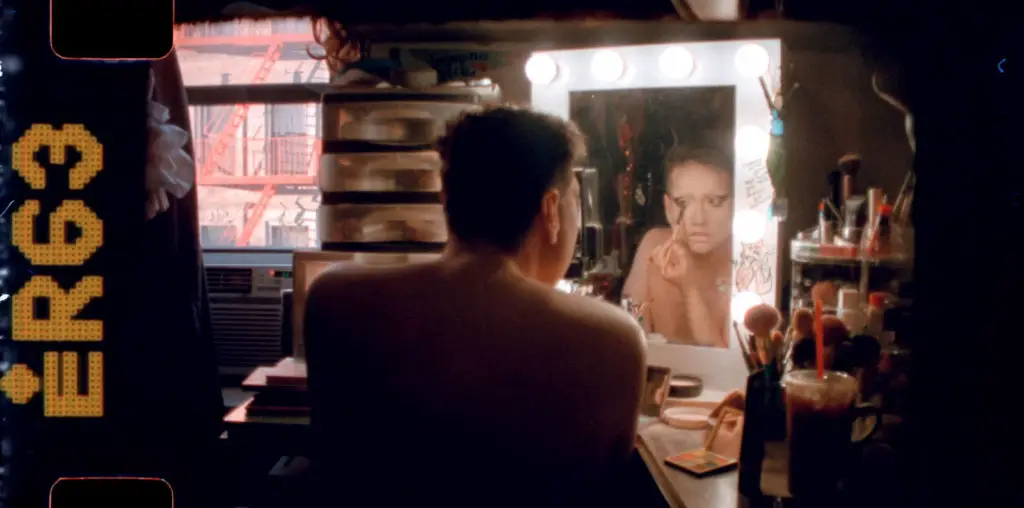
In my opinion, breaking up with Tom Cruise was the best career move Nicole Kidman has made. While she was still under the sway of the once and future Maverick, Kidman seemed content to make predictable and increasingly bland money pictures (“To Die For” notwithstanding). But the post-Cole Trickle era has yielded some interesting choices on her part. Heck, I even enjoyed her in Dogville, and I know the opinion Phil Hall had in his review here at Ye Olde Film Threat.
So her teaming up with Sean Penn, who has emerged as one of the finest actors of this generation after narrowly avoiding becoming typecast as Spicoli for life seemed very interesting to me. Couple that with the direction of Sydney “Really, I realize ‘Random Hearts’ was a mistake” Pollack and you have the foundation for a pretty decent movie.
The one marketing hurdle they have to overcome here is the fact that no one in the movie currently has a sitcom on either the WB or the Disney Channel.
The Poster
I like the use of darker colors, but the overall design leaves me feeling somewhat, I don’t know, cold. What this really looks like is the cover of a paperback book. The inclusion of the United Nations building sets the scene nicely as this location is central to the plot of the movie, but the way the designers arranged Kidman and Penn seems awkward. The design doesn’t allow the viewer’s eye to flow from one point to the next. In the end though, the poster does make the movie look like a film made by adults for adults and, since that’s what it actually looks to be, it can’t be accused of misrepresentation.
What the trailer does very nicely is hint at the multiple levels of intrigue and espionage going on in the movie. The plot is setup quickly and then almost completely dispatched as the focus shifts to the investigation by Penn into not only the allegations made by Kidman but who Kidman’s character is and what her agenda might be. I love this trailer and the way it shows just enough to get the viewer asking, “So what is going on?” You really have to pay attention to the trailer and that right there is going to separate the wheat from the chafe in terms of potential audience.
I’ve long complained that studios aren’t doing anything original with their movie websites. My problems range from a general boringness in the designs to their not grasping the full potential a site has to be a multimedia delivery platform. At least in terms of design, the folks at Universal have broken out of the box with their site for “The Interpreter”.
I don’t know quite how to describe the site. It’s Flash-based but very cool. Nothing is laid out in an easy-to-use way. Instead, you have to move your mouse around to go up, down and to the side on the site. Only by moving it around will you eventually uncover the content that seems hidden. Mousing over a little box reveals the sections you can then drill-down into for the good stuff.
First the rudimentary portions of the site:
“About the Film” contains a pretty brief look for a movie that’s described as complex and multi-layered under the Story heading. Also, there are “Production Notes” which go into great detail on all aspects of the movie, especially focusing on the challenges of filming at the actual U.N. Standard bios of the Cast and Crew can be found under “Cast and Crew”. The standard wallpapers, AIM icons and a screensaver are collected under the “Downloads” heading. A mix of behind and in front of the scenes pics can be viewed in the “Gallery”.
Now to the more eclectic offerings.
Trailers, TV spots and more are lumped together under “Media”. One of the best items here is a series of interviews with a real U.N. interpreter. These are fascinating and really show just how much access Pollack and his production were granted for the movie. If you have any interest at all in politics you’ll want to check these out.
“Inside the U.N.” is again a fascinating look at the actual United Nations. There’s no real tie-in to the events of the movie, but I think the inclusion of this historical material gives background information that is essential on the subject. The section is arranged like a timeline, complete with video and photos of the construction of the building right up to the present day. The oldest archival video footage has had sound effects added to it rather needlessly but it’s still great to have this kind of information made available.
Finally, there’s a game called “Interpret This” which initially made me think of the next Billy Crystal/Robert DeNiro team-up. In actuality the game gives you some arcane phrase or analogy. You then must choose from a list the correct interpretation of that analogy. It’s kind of fun if you’re, you know, a dork.
Overall
There’s no mistaking, from the somber tone of the poster to the high-mindedness of the trailer to the emphasis on history on the website that the marketing team knows their audience will be adults and are aiming squarely at that group. There’s no pandering, dumbing down or insulting going on in the entire campaign. Even the design of the website rewards patience over shiny baubles you can easily click to find stuff. This is a great campaign for a movie that easily could have been tossed into theaters as just a way to get it off the shelves before the summer blockbusters hit.
As moviemaking costs increase, the pressure to successfully market those movies becomes greater. In an attempt to show how marketers are trying to put the most hinders in the theater seats, Chris Thilk breaks down why some movie campaigns work and some don’t. The posters for “The Rocketeer” and “Unforgiven” remain two of his all-time favorites. For Chris’ ongoing movie journal and other various musings, visit his Movie Marketing Madness blog.

